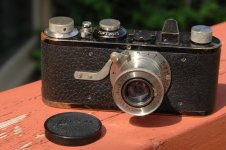Dez
Bodger Extraordinaire
I have seen lots of different advice on how to deal with pinholes in an old Leica shutter, some of them involving paying a labour rate that would be attractive to the average brain surgeon, but being really basically very cheap, that is, thrifty, I needed another approach. I have heard of various results with fabric paints, and I thought I would share my experiences.
I have a very nice Leica A, with a serial number around 10,000, and a close-focusing Elmar. I bought it on ebay a few years ago, and it was fairly easy to deal with. The cloudiness in the lens was just condensate from the aperture lube, which had not yet started fungus growing, so that was quite easy, some cleaning and relubrication, and the aperture and focus would move without excessive force, and the shutter was willing to co-operate with just a bit of cleaning within the round housing on the top of the camera. All was happiness until I put a film through it. The good news was that it exposed evenly and fairly accurately at every shutter speed; the bad news was that I had lots of tiny pinholes. A little experimenting showed that both curtains had the problem.
I found a sample of fabric about the same weave density as the shutter curtain, and tried a few different solutions. I found that fabric screening paint did a splendid job of colouring the threads, but did nothing at all about filling in the holes unless applied very heavily, I ended up trying the highest quality artist's acrylic I could find- the highest concentration of pigment vs carrier. The material I ended up with, American made, but I bought it in Toronto and I'm told it is widely available, is the Mars Black acrylic pigment, by M. Graham & Co, of West Lynn Oregon. It is a very intense black.
Although acrylic paint is quite flexible when dry, it is easy to put too much on and cause the curtain to stiffen up too much. I mixed the pigment with about 1/3 water to thin it down a bit, and used a brush to apply it to the areas needed. Then I carefully rubbed it into the fabric with a finger. Do not try to do this without taking the body shell off the camera- you need a strong light source to find all the pinholes, and you must support the shutter curtain from behind when working on it. Again be careful not to use too much, or you will have a perfectly opaque but immobile shutter. I used a desk light with a small halogen bulb for my light source, which both finds the holes and allows quick drying of the paint. And while I had the shell off, I did the proper job of cleaning and relubricating the shutter I should have done in the first place.
A word of caution. The shutter in my camera still looked good. There was no obvious checking or cracking such as you tend to see in old Exaktas. I suspect if the shutter got into that state this fix would never work. There is no sign of light leaks now, so my old Leica can go back to taking the sort of pictures it used to- the kind that has one rationalizing about ethereal colour rendition and attractive OOF areas, as opposed to sharpness and contrast! Here's an example which is not too bad for being handheld at 1/20th of a second. This was before the dinner and wine, of course.
I have a very nice Leica A, with a serial number around 10,000, and a close-focusing Elmar. I bought it on ebay a few years ago, and it was fairly easy to deal with. The cloudiness in the lens was just condensate from the aperture lube, which had not yet started fungus growing, so that was quite easy, some cleaning and relubrication, and the aperture and focus would move without excessive force, and the shutter was willing to co-operate with just a bit of cleaning within the round housing on the top of the camera. All was happiness until I put a film through it. The good news was that it exposed evenly and fairly accurately at every shutter speed; the bad news was that I had lots of tiny pinholes. A little experimenting showed that both curtains had the problem.
I found a sample of fabric about the same weave density as the shutter curtain, and tried a few different solutions. I found that fabric screening paint did a splendid job of colouring the threads, but did nothing at all about filling in the holes unless applied very heavily, I ended up trying the highest quality artist's acrylic I could find- the highest concentration of pigment vs carrier. The material I ended up with, American made, but I bought it in Toronto and I'm told it is widely available, is the Mars Black acrylic pigment, by M. Graham & Co, of West Lynn Oregon. It is a very intense black.
Although acrylic paint is quite flexible when dry, it is easy to put too much on and cause the curtain to stiffen up too much. I mixed the pigment with about 1/3 water to thin it down a bit, and used a brush to apply it to the areas needed. Then I carefully rubbed it into the fabric with a finger. Do not try to do this without taking the body shell off the camera- you need a strong light source to find all the pinholes, and you must support the shutter curtain from behind when working on it. Again be careful not to use too much, or you will have a perfectly opaque but immobile shutter. I used a desk light with a small halogen bulb for my light source, which both finds the holes and allows quick drying of the paint. And while I had the shell off, I did the proper job of cleaning and relubricating the shutter I should have done in the first place.
A word of caution. The shutter in my camera still looked good. There was no obvious checking or cracking such as you tend to see in old Exaktas. I suspect if the shutter got into that state this fix would never work. There is no sign of light leaks now, so my old Leica can go back to taking the sort of pictures it used to- the kind that has one rationalizing about ethereal colour rendition and attractive OOF areas, as opposed to sharpness and contrast! Here's an example which is not too bad for being handheld at 1/20th of a second. This was before the dinner and wine, of course.



